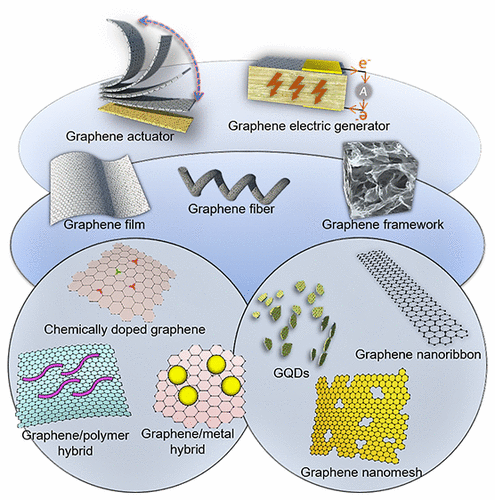当前位置:
X-MOL 学术
›
Acc. Chem. Res.
›
论文详情
Our official English website, www.x-mol.net, welcomes your
feedback! (Note: you will need to create a separate account there.)
Graphene-Based Functional Architectures: Sheets Regulation and Macrostructure Construction toward Actuators and Power Generators
Accounts of Chemical Research ( IF 16.4 ) Pub Date : 2017-06-28 00:00:00 , DOI: 10.1021/acs.accounts.7b00131 Huhu Cheng 1, 2 , Yaxin Huang 1 , Gaoquan Shi 2 , Lan Jiang 1, 3 , Liangti Qu 1, 4
Accounts of Chemical Research ( IF 16.4 ) Pub Date : 2017-06-28 00:00:00 , DOI: 10.1021/acs.accounts.7b00131 Huhu Cheng 1, 2 , Yaxin Huang 1 , Gaoquan Shi 2 , Lan Jiang 1, 3 , Liangti Qu 1, 4
Affiliation

|
Graphene, with large delocalized π electron cloud on a two-dimensional (2D) atom-thin plane, possesses excellent carrier mobility, large surface area, high light transparency, high mechanical strength, and superior flexibility. However, the lack of intrinsic band gap, poor dispersibility, and weak reactivity of graphene hinder its application scope. Heteroatom-doping regulation and surface modification of graphene can effectively reconstruct the sp2 bonded carbon atoms and tailor the surface chemistry and interfacial interaction, while microstructure mediation on graphene can induce the special chemical and physical properties because of the quantum confinement, edge effect, and unusual mass transport process. Based on these regulations on graphene, series of methods and techniques are developed to couple the promising characters of graphene into the macroscopic architectures for potential and practical applications. In this Account, we present our effort on graphene regulation from chemical modification to microstructure control, from the morphology-designed macroassemblies to their applications in functional systems excluding the energy-storage devices. We first introduce the chemically regulative graphene with incorporated heteroatoms into the honeycomb lattice, which could open the intrinsic band gap and provide many active sites. Then the surface modification of graphene with functional components will improve dispersibility, prevent aggregation, and introduce new functions. On the other hand, microstructure mediation on graphene sheets (e.g., 0D quantum dots, 1D nanoribbons, and 2D nanomeshes) is demonstrated to induce special chemical and physical properties. Benefiting from the effective regulation on graphene sheets, diverse methods including dimension-confined strategy, filtration assembly, and hydrothermal treatment have been developed to assemble individual graphene sheets to macroscopic graphene fibers, films, and frameworks. These rationally regulated graphene sheets and well-constructed assemblies present promising applications in energy-conversion materials and device systems focusing on actuators that can convert different energy forms (e.g., electric, chemical, photonic, thermal, etc.) to mechanical actuation and electrical generators that can directly transform environmental energy to electric power.
中文翻译:

基于石墨烯的功能架构:面向执行器和发电机的薄板调节和宏观结构构造
石墨烯在二维(2D)原子薄平面上具有大的离域π电子云,具有出色的载流子迁移率,大表面积,高透光性,高机械强度和出色的柔韧性。但是,由于缺乏固有的带隙,分散性差,石墨烯的反应性弱等原因,阻碍了石墨烯的应用范围。石墨烯的杂原子掺杂调控和表面改性可以有效地重建sp 2碳原子键合并调节表面化学和界面相互作用,而石墨烯上的微结构介导则由于量子限制,边缘效应和异常的质量传输过程而具有特殊的化学和物理性质。基于对石墨烯的这些规定,开发了一系列方法和技术,以将石墨烯的有前途的特征耦合到宏观体系结构中,以进行潜在的和实际的应用。在此报告中,我们介绍了从化学修饰到微结构控制,从形态学设计的宏组件到它们在功能系统(不包括储能装置)中的应用方面对石墨烯调节的努力。我们首先将具有杂原子的化学调节石墨烯引入到蜂窝晶格中,这可以打开内在的带隙并提供许多活性位点。然后,通过功能成分对石墨烯进行表面改性将提高分散性,防止聚集并引入新功能。另一方面,已证明在石墨烯片上的微观结构介导(例如0D量子点,1D纳米带和2D纳米网)可诱导特殊的化学和物理性质。受益于对石墨烯片的有效监管,已开发出多种方法,包括尺寸限制策略,过滤组装和水热处理,以将单个石墨烯片组装成宏观的石墨烯纤维,薄膜和框架。
更新日期:2017-06-28
中文翻译:

基于石墨烯的功能架构:面向执行器和发电机的薄板调节和宏观结构构造
石墨烯在二维(2D)原子薄平面上具有大的离域π电子云,具有出色的载流子迁移率,大表面积,高透光性,高机械强度和出色的柔韧性。但是,由于缺乏固有的带隙,分散性差,石墨烯的反应性弱等原因,阻碍了石墨烯的应用范围。石墨烯的杂原子掺杂调控和表面改性可以有效地重建sp 2碳原子键合并调节表面化学和界面相互作用,而石墨烯上的微结构介导则由于量子限制,边缘效应和异常的质量传输过程而具有特殊的化学和物理性质。基于对石墨烯的这些规定,开发了一系列方法和技术,以将石墨烯的有前途的特征耦合到宏观体系结构中,以进行潜在的和实际的应用。在此报告中,我们介绍了从化学修饰到微结构控制,从形态学设计的宏组件到它们在功能系统(不包括储能装置)中的应用方面对石墨烯调节的努力。我们首先将具有杂原子的化学调节石墨烯引入到蜂窝晶格中,这可以打开内在的带隙并提供许多活性位点。然后,通过功能成分对石墨烯进行表面改性将提高分散性,防止聚集并引入新功能。另一方面,已证明在石墨烯片上的微观结构介导(例如0D量子点,1D纳米带和2D纳米网)可诱导特殊的化学和物理性质。受益于对石墨烯片的有效监管,已开发出多种方法,包括尺寸限制策略,过滤组装和水热处理,以将单个石墨烯片组装成宏观的石墨烯纤维,薄膜和框架。











































 京公网安备 11010802027423号
京公网安备 11010802027423号